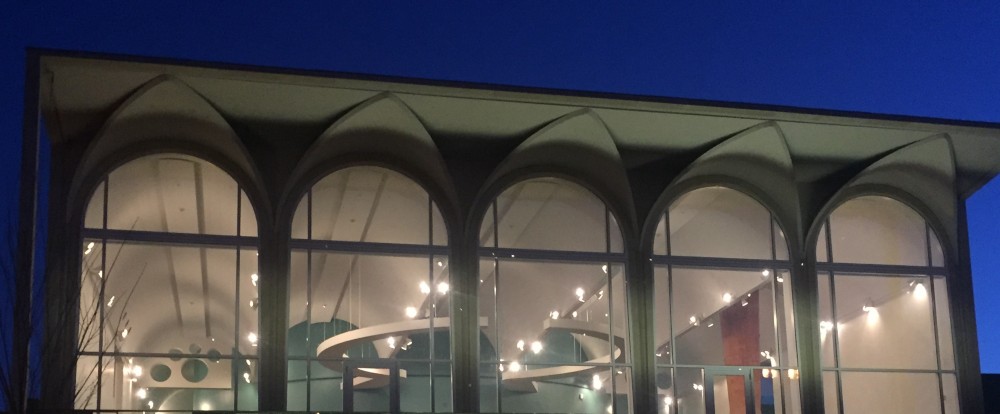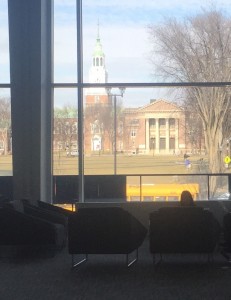Of Oldenburg’s criteria for third space, the Top of the Hop fulfills the first 7. However, the dissimilarity with the eighth feature is notable and also central to the identity of the Top of the Hop which is why I believe this area requires a more nuanced term than simply a Third Space. Below is an infographic depicting the qualities that the Top of the Hop exhibits and those it does not. Following that are details about the space that explain why it only fits some of the criteria.
Free or inexpensive
The Top of the Hop is not only open to all Dartmouth students, but also the general public at most times. Most events held there are free and tickets for student ensemble performances are only $5,
Food in close proximity
The Courtyard Cafe is located just downstairs and students often grab food there and come up to the Top of the Hop to eat.
Highly accessible
Dartmouth is such a small campus and Hanover such a tight knit town that it is easily accessible. There is an elevator the the Top of the Hop and the floor is otherwise flat or has slowly inclining ramps so anyone could use the space and accommodations are easily made.
People can congregate there
The room is so large that people can congregate there for a variety of reasons, from simply working on a group project to a guest speaker having a lecture and event.
Neutral ground and low profile
This area is absolutely a neutral ground. Especially when the Top of the Hop is being used as a study space, no one has control over other people’s actions or choices in how they use the space and the area is open and un-intimidating. The design features lean towards simplicity and practicality over grandioseness. This also allows the Top of the Hop to be malleable to fulfill its many functions.
Playful mood
Because it is located in the performing arts center and there are often performances in the Top of the Hop, the mood is usually playful. Even when it is being used as a quiet study area the windowed, back wall, with its beautiful view of campus, elevates this to being a happier study space compared to the library.
Conversation is the main activity
However, as stated before, conversation is often not the main activity here. The Top of the Hop attracts a variety of people that may not necessarily interact otherwise. However, the space does not foster, or even encourage, interaction and conversation. Rather, the space is open and malleable for people to come in and make of it what they will. I think this relates to a social psychologist, Kurt Lewin’s point about behavior, “Behavior is a function of the person, his or her environment, and the interaction between the two”. People who come to the Top of the Hop interact with the space rather than each other and thus their behavior is shaped more by the space than the people around them.
The reason that I say that the Top of the Hop is a version of, rather than an example of, third space is because it diverges from Oldenburg’s definition with respect to the above criterion. Thus I modified the term “third space” with the adjective self-contained because although people often find a space outside of work and home here, they are still within themselves. Oldenburg’s examples of third spaces are very social and fostered a lot of conversation and involvement among the people in the space. Often third spaces were meeting areas for specific groups with common interests so interaction was inevitable.
Merriam-Webster defines “self-contained” as describing something that is complete within itself. This adjective perfectly describes students’ behavior in the Top of the Hop. Students seem to come to the Top of the Hop with a purpose or at least some task to accomplish in their time there- whether it is to view a performance, listen to a guest speaker, participate in a career fair, or simply finish an essay. All of these activities are not exactly social but they still fulfill a need outside of work and home. Furthermore, the space allows for them to maximize their ability to be within themselves. For example, chairs can be moved anywhere so people can find a private corner of the room. Although the room is so large, it is open and doesn’t have many structures in the middle of it so you can be aware of, and even a part of, everything going on in the space. This creates exceptional publicity.
Although I chose the adjective self-contained to describe the behavior of students and other visitors to the Top of the Hop, it is still appropriate to term the Top of the Hop, and other spaces like it, a self-contained third space. This is because, as mentioned previously in Lewin’s quote, a space is largely defined by the behaviors of people in it. The takeaway from creating this term “self-contained third space”, providing an example of it, and articulating the qualities of the space that qualify it as a self-contained third space, is that it adds to the conversation about spaces and their purpose in day to day life. Previously, spaces similar to the Top of the Hop seemed to be undefinable and too multipurpose to be nailed down by one term. However, by adding “self-contained third space” to the vernacular, it allows others to potentially identify them in their own lives. Furthermore, if they desired to create a “self-contained third space” in another area, they would have some guidelines to follow and examples to model.



